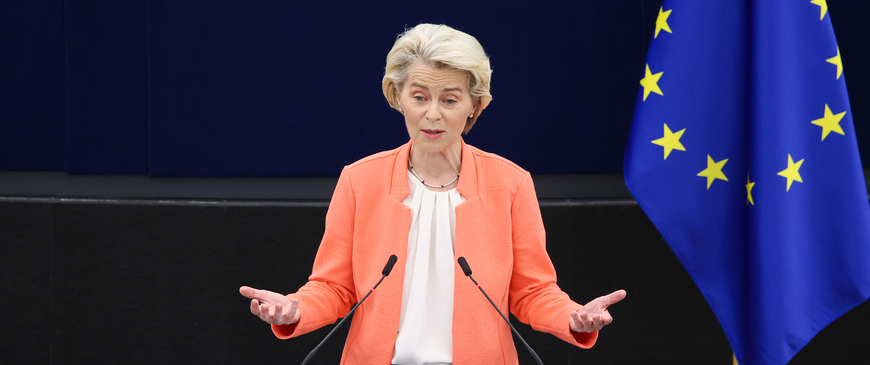
The EU still needs to build its de-risking toolkit
‘De-risking’ the EU’s economic ties with China took centre stage in this week’s state of the union speech by European Commission President von der Leyen. But the EU’s de-risking efforts so far have revealed major limitations in its policy toolkit that need to be addressed.
Take the US efforts to throttle China’s access to advanced computing chips, a centerpiece of its de-risking agenda. Washington’s road invariably led to the Netherlands, home to ASML, the global leader in the lithography machines necessary to build cutting-edge chips. The US persuaded the Dutch to ban ASML selling trailing-edge lithography equipment to China (the Dutch banned the sale of cutting-edge machines in 2019). What was striking in the entire episode was the absence of Brussels, Paris and Berlin.
It is unclear what the Dutch won from agreeing to Washington’s demands. But if the US had been negotiating with the EU as a bloc, it is possible the EU could have struck a more strategic bargain. The single market only produces 10 per cent of the global chips supply and remains reliant on imports for its chip demand,. Subsidies for chip-making in Europe are unlikely to dent this much. The ASML deal was a missed opportunity to get US help to guarantee future European access to chip technology from the US itself but also Japan, Taiwan and South Korea, each of whom are home to firms that dominate certain parts of the value chain. This would also have been in the Dutch interest: 23 per cent of its exports go to Germany. If German manufacturing is choked off from chips, the Dutch economy will inevitably struggle too.
The wider lesson from the ASML episode is that the EU needs to Europeanise tools like export controls because the US retains the power to pull Europe into its orbit when it wants. De-risking will not only be focused on diversifying suppliers to Europe, or export markets, but also about trying to protect critical technologies from falling into the hands of autocratic geopolitical rivals – either because the EU deems it vital for its own security or the US demands it. The EU’s so-called ‘dual use’ regulation for export controls gives member-states discretion to impose controls “for reasons of public security, including the prevention of acts of terrorism, or for human rights considerations”. Member-states will not make these decisions by thinking sufficiently of the wider interests of the EU single market. Yet the point of de-risking is to protect the EU's ability to make decisions in its own interest. And this can apply not only to coercion by China, but also pressure by the US. Making export controls an EU competence can help deliver that by setting de-risking goals for the single market as a whole and reducing the risks that China or the US leans on individual member-states.
Opponents of such a course of action bet, instead, on coordination between the member-states. But when it comes to deciding whether to align with the US on China, coordination has been lacking for years. Take screening of cross-border investment. European countries have different stances on letting Chinese firms build 5G infrastructure in Europe. As it stands, only a third of EU countries have banned Huawei from critical parts of their 5G communications, whereas in 2022, 59% of the 5G network in Germany comprised Chinese equipment, although Berlin is changing its policy now.
The other challenge facing the EU is that it lacks common pots of money to roll out an industrial strategy for the whole single market. In the race for green technology, Europe is fretting about losing out to subsidised production in the US and China. But the EU is starting from a stronger position in green technology manufacturing than often presumed. China’s share of global exports in 220 low carbon technologies has exploded, from 23 per cent in 2019 to 34 per cent last year. The EU’s sizable share has also grown to 23 per cent while the US is stuck on 13 per cent. However, data released by the European Commission shows that Germany and France are now vastly out-subsidising other EU countries. This divergence may drive companies in other EU countries out of business or stifle competition and innovation.
The EU can afford a genuine EU-wide industrial policy. “Its overall debt levels are not dissimilar to the US and the UK. But fiscal space is unequally divided across the Union and low-debt frugal countries, led by Germany, are not willing to further pool budgetary resources. The Commission’s proposed ‘sovereignty fund’ plasters over what a real EU industrial policy might look like: it asked for merely 10 billion in fresh funds, and mostly just redirects existing EU pots. As a result, subsidies will stay primarily in the realm of national industrial policy. As the Commission just announced an investigation of China’s electric vehicle (EV) subsidies, the EU may end up opting for blunt traditional methods like tariffs on Chinese electric vehicles, almost by default, instead of being able to also draw on a more integrated EU industrial policy that can deliver better outcomes.
Restricting European consumption subsidies to vehicles built in the EU or imported from a country where there is no subsidised production, are more aligned with the Sino-American approach of having ‘local content requirements’. Reciprocating the policy would make it easier for the EU to argue that it is merely levelling the playing field and reduce the risk of Chinese retaliation.
While trade policy is already an EU prerogative, the wider toolkit necessary for de-risking, including export restrictions and foreign investment controls remains national. As a result, decisions remain sluggish and fragmented, leaving the EU exposed to pressure from China or the US. To truly protect itself from mercantilism, the EU should expand its economic policy toolkit and rig up a genuine single-market compatible industrial policy.
Sander Tordoir is senior economist at the Centre for European Reform.
